Business
10 Ways to Maximize On Your Social Media Messaging
Published
6 years agoon
By
Joanna Lam
Figuring out what you really want to do with life and share with others is not easy. There are so many options nowadays, and if there isn’t something out there that you want to do, you can create the opportunity. After deciding on your social media messaging strategy, these steps below will help you maximize your reach and spread your message through social skills and social media.
Have a clear message
When it comes to your social media messaging strategy, have a clear message that is short, to the point and simple to understand. Someone who is viewing your content for the first time should be able to know what you are providing them in a couple of seconds. Don’t lose a potential client/follower because they did not know what you are marketing.
Hook your audience in three seconds and keep their attention. People scroll through social media feeds very quickly. Your content needs to stop them in their tracks then have them scroll back to see what you posted. It can be an attention grabbing title, a stunning location they would want to visit, an adrenaline pumping video or an abstract photo that gets them confused and wanting to figure out what is going on.
Once you’ve hooked them, they will now want to check out the rest of your content. Stay constant with your message throughout your content. Focus on one message at a time. What is your core value and the first thing you want your audience to know? Once you have grown your first message then you can expand and pick up another message to share.
Provide value with your content
Now that you have a clear message with what you are marketing, how will it provide value to your audience? Whether you are selling a product or a service, how does it make your user’s life easier? A value doesn’t have to be something monetary or physical. Provide social media messaging that can inspire your audience. Something to motivate them to get up and do something. Believe it or not, envy is also a good motivation. That’s why social media influencers have the job they do. They market their content in a why that makes you want to be in their shoes.
Everyone who is following you is doing so for the same reason, they like whatever you are offering them. That is at least one thing they all have in common. Build a community where they can connect with you and each other on a more personal level than just commenting on each other’s post. Give them somewhere to go to talk about and share similar ideas.
Understanding and responding to your audience
Understand what excites your audience. Understand what made them follow you in the first place. If you can find out what gets them excited and wanting to share your product, you will have them doing half of the marketing for you. Take the Starbucks social media messaging strategy for example. People like personalized things. Something as simple as writing their name on a cup will have them taking a picture of it and sharing it on social media and with friends. Free publicity for Starbucks. Add some hearts or funny misspellings and you’ve got yourself a winning cup.
When you are provided feedback, listen to them. Gather what your friends, family and audience has said and respond if the request or advise is reasonable and in good taste. They will feel like they are a part of your journey and appreciate it. Surround yourself with positive people who want to see you succeed. You don’t have to remove anyone from your life, they just don’t have to be a part of your growing process. There is a difference between people who are shut down every idea you have and people who critique your work. Find people who will provide honest feedback to better yourself and your work. That can be people in your circle, in your interested community, Reddit or Facebook groups. Believe in yourself and your work. Also, you are your hardest critic. So don’t forget to celebrate how far you are come. And don’t forget to celebrate with your audience. They are part of the reason you are where you are. Create milestones and little celebrations.
Making connections
It’s not what you know, it’s who you know. Sadly, that cannot be true enough. Yes, you still need solid skills and products but the first step is to get in and get noticed. This is why people collaborate. In order to reach the audience of the other group. If you notice, social media influencers, Youtube especially, collaborate with each other through a combined social media messaging strategy. They understand that the audience of the person they are collaborating with are all potential new audience for themselves. When you see a new person mentioned in your favorite YouTuber’s video, you go and check out what they have to offer as well.
Collaboration and networking is very important. It can also be very annoying. If you are an introvert, networking is actually one of the most dreaded task. But not all networking has to be in a conference room. When you chatting and connecting with someone, whether it is your neighbor or the barista, that is networking. Those are the kind of networking that will last longer. They are more genuine. Neither side went hoping to get something out of the situation.
Understanding the different social media platforms and which ones work for you
Anyone who wants to get their message across needs to be on social media. Word of mouth is great but that can only spread so far. Being active on social media will draw in clients from all around the globe. But it’s not good enough to just be on every social platform. You need to be constantly active on each one with a clear social media messaging strategy catered to individual platforms. And learn all the ins-and-outs of what makes each platform unique. That can be very overwhelming. Pick one or two platforms to focus on first. Grow a real following with an active community and get in the swing of things before moving on to the next.
Have a unique offering
What makes what you are offering better than what is already out there? Like Apple, you do not have to be the first at something but you have to be better. Whether you are marketing a lifestyle or material goods, add your personal touches to it. People get tired of seeing the same things over and over. That makes social media messaging boring for you and your audience. Everybody is unique and different. And people get bored of the same old thing. So if you add a bit of your personality and style into your work, that will shine brighter and market better than if you were to stick with the standard.
But be ready. Have something to showcase your work whether it is a website or a media kit. You don’t want to throw something together last minute. The quality of a last minute project will never be as great as something well prepared and thought out. And make sure to keep it up to date. When the opportunity arises, you have to be prepared.
Quality over quantity
People like high quality things. This is why new models come out every year and video quality keeps getting higher. The quality of your content needs to be your best work. Make sure the photos you are sharing vibrant, your videos at the highest quality. Make people want to share your content on their site or tag a friend. Give them a story they want to be a part of.
Keep an idea or inspiration board to pull from for days you need a little motivation. Also, think about what made you inspired by their content. Did it invoke a feeling? Was it something you always wanted to do? What was it about the photo that made you want to save it? Keep those things in mind and think about how you can bring those feelings to your work.
Make it searchable
If you were to Google something related to what you are marketing, what phrases would you search? When creating social media messaging content, keep in mind the phrases or words you yourself would search for. Have a good caption or description. Use keywords. There are tons of resources online that provide you with a list of words to make your content more searchable. A good course to learn more about this is the Google Adword course. You can read more about that course here.
Spend money to make money (not just literally)
Invest in yourself. Invest in your hobby and your passion. More importantly, invest in your business. Investments are not just material goods but also skills as well and marketing social media messaging tactics that will help maximize your reach and impact.
Yes, you still need to have proper gear whether it is a tripod if you are a photographer, software or hardware if you are a designer, a good blender if you are a chef. Do your research based on your budget and availability.
If you are providing a skilled based service, take classes and attend workshops. You can practice, network and get fresh perspective from people in your class. Sometimes, the newbie asking the “dumb” questions will actually be the one with the most out-of-the-box brilliant ideas. They are not used to what the “standard” is so they will have a different frame of mind than what you are so used to.
Once you have some solid content, you are ready to start marketing. Along with marketing through social media, friends, family and your network, look into paid marketing. Think about how much big companies pay for ads. They would not be spending that kind of money if it did not work. You probably don’t need a big billboard on the side of the highway but you will benefit from ads and marketing on social media. Do your research on what social media platforms your target audience would most likely be on, what time of day they are most active, what other things do they follow.
Timing
Time your content to coincide with special events or holidays. Is there a random holiday that you can work your content around? National llama day is coming up, December 9th. If the holiday is big enough or silly enough, social media accounts have special features on them. Work your content around those holidays to get your content featured on the main page.
Keep an ear out for what is trending at the moment? Get into high school gossip mode! What are people talking about? Whether it is good or bad, how does your content apply? Get creative but always make sure you are true to your message.
I take too many pictures. A month without any kind of adventure makes me antsy. The water is my home.

You may like
Business
Top 10 Best Places to Buy a Mid Century Modern Office Chair
Published
2 weeks agoon
July 4, 2025
What was once old is new again: mid century modern is back in style. From architecture to furniture, the postwar look is in, and the hype extends all the way to office chairs.
Do you need a mid century modern office chair in your life? If so, there’s plenty to choose from. Your office chair should be tailored to your style, whether you like luxury, utility, or something in between.
That’s why we’ve put together our 10 favorite places to find your ideal mid century modern office chair.
What is mid century modern design?
After World War II, spirits were high in the US, and new technology was taking the country by storm. Mid century modern refers to the design concepts that came about during this time.
As opposed to the frilly, ornate designs of classical furnishings, mid century modern designs are angular, material, and functional. Wood is a common design element, especially teak. Mid century modern furniture may also have materials like glass, vinyl, and metal. Designs are simple and geometric, with bold accent colors to make them pop.
The mid century modern aesthetic never really went away, but it’s made a noted comeback in recent years. Some have chalked it up to Boomer and Gen X nostalgia, others point to mid-century-set shows like Mad Men and The Marvelous Mrs. Maisel.
Why should I buy a mid century modern office chair?
Mid century modern is the perfect fusion of style and utility. If you want to cultivate an office space that commands respect without being ostentatious, mid century modern is the style for you.
When it comes to office chairs, an MCM one is often made with sturdy wood and vinyl. They combine the ergonomics of a modern office chair with old-fashioned grace.
If you’re concerned with utility and utility only, a more bog-standard office chair may suit you. But a mid century modern office chair is great for someone who wants to wow colleagues with a mature, thoughtful business space.
Where can I get a mid century modern office chair?
1) Wayfair
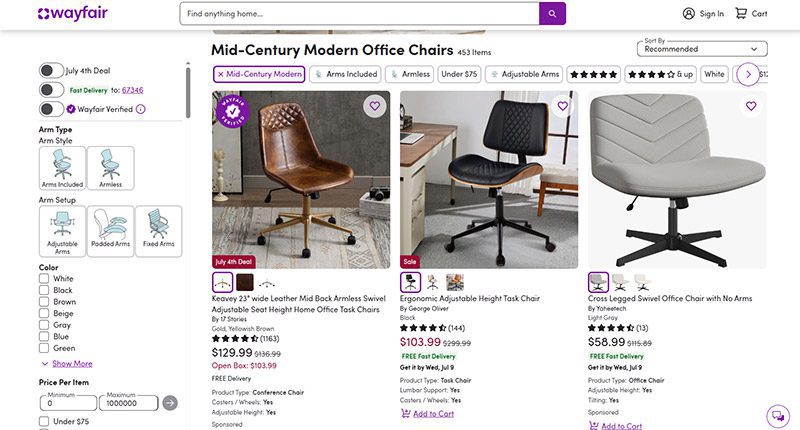
When it comes to furniture, Wayfair offers the best of both worlds. Their goods, including their mid century modern office chairs, are stylish and affordable. You can get a sturdy task chair for less than $100 or a more distinguished seat for less than $350.
MCM office chair examples: Dovray ($126), Bradford ($139), Lithonia ($133)
2) France & Son
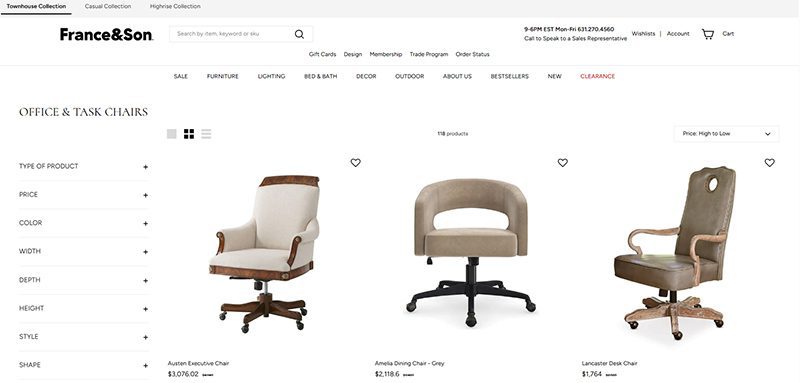
Wayfair’s chairs are affordable, but France & Son is the perfect option for luxury shoppers. Their mid century modern office chairs are robust and sleekly designed. If you dress to impress and enjoy the finer things in life, these are the chairs for you.
MCM office chair example: Brooks ($695)
3) Houzz

Started as a community for people to share home decor tips, Houzz has become a great ecommerce platform for finding stylish furniture. They’re more known for home decor than desk chairs, but they have plenty of great, affordable finds if you know where to look.
MCM office chair examples: Arvilla ($173), Rathburn ($259)
4) Laura Davidson
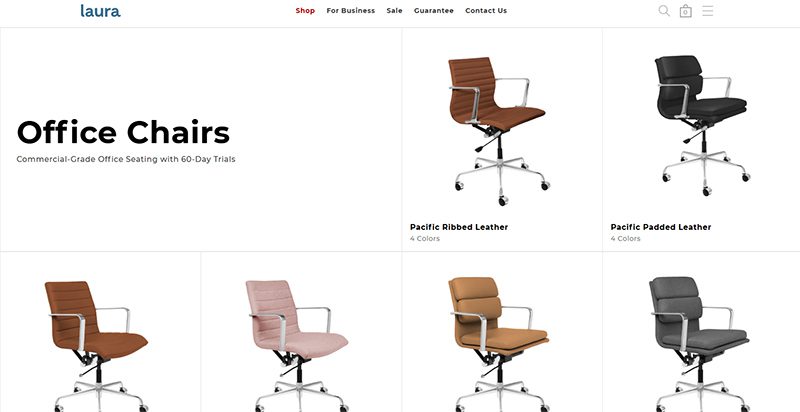
The Laura Davidson collection offers a fairly limited selection of classic office furniture. Still, there’s a reason they’re trusted by big-wigs like Apple, Disney, and Salesforce. Their chairs are sturdy and beautifully designed, reimagining classic Eames and Knoll designs.
MCM office chair examples: Rockefeller ($275), SOHO II Soft Pad ($450)
5) Icons of Manhattan
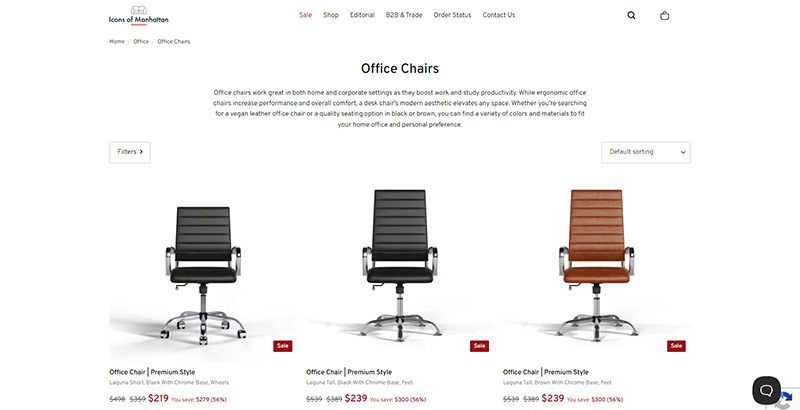
Icons of Manhattan has a simple philosophy: do one thing, and do it right. Their office chairs are handcrafted from premium materials and tailored to a mid-century modern style. If you want that Mad Men energy in your office (hopefully with a lot less angst), these are the chairs for you.
MCM office chair example: Ribbed Medium ($219)
6) Amazon
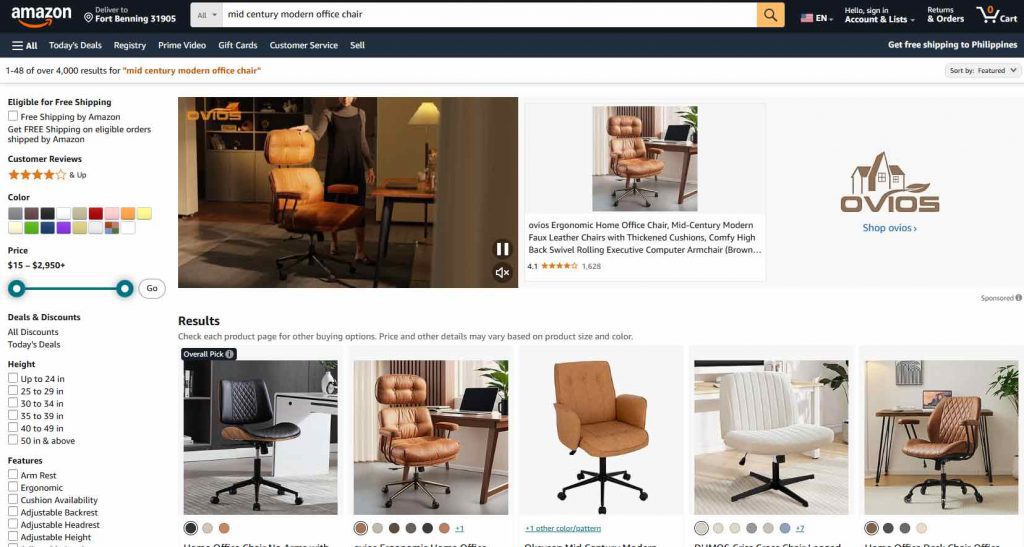
Yes, the internet’s premier shopping destination has a robust collection of mid century modern office chairs. Like with most products, their selection of seats is vast and can be hit or miss. Still, they’ve got stunning chairs available for any style, whether you care about comfort, class, or ergonomics.
MCM office chair examples: IDS Home Modern ($219), Art Leon MCM Swivel ($139)
7) AllModern
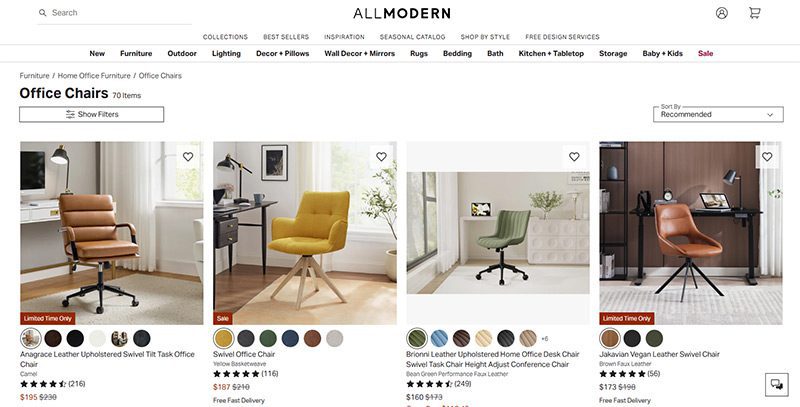
AllModern’s collection of desk chairs and other furniture truly embodies the mid century modern spirit. Their work is tight, angular, and functional above all. They’re part of the Wayfair family and they traffic in a number of modern styles, but their sleek chairs are perfect for any mid century modern space.
MCM office chair examples: Frederick ($229), Kealey ($349)
8) Overstock
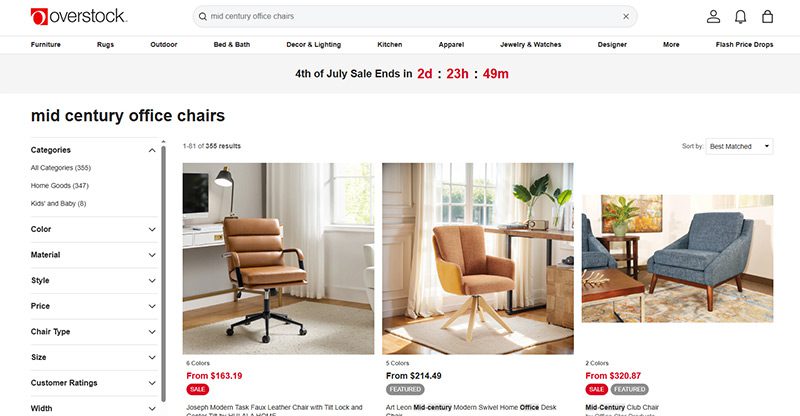
Overstock is known as a one-stop shop for quality home goods at sub-wholesale prices. If you want a spiffy mid century modern office chair that won’t break the bank, they’re the first place to look. While they’re somewhat less reliable than the more upscale platforms on this list, their selection is massive.
MCM office chair example: Joseph Modern ($163)
9) Walmart
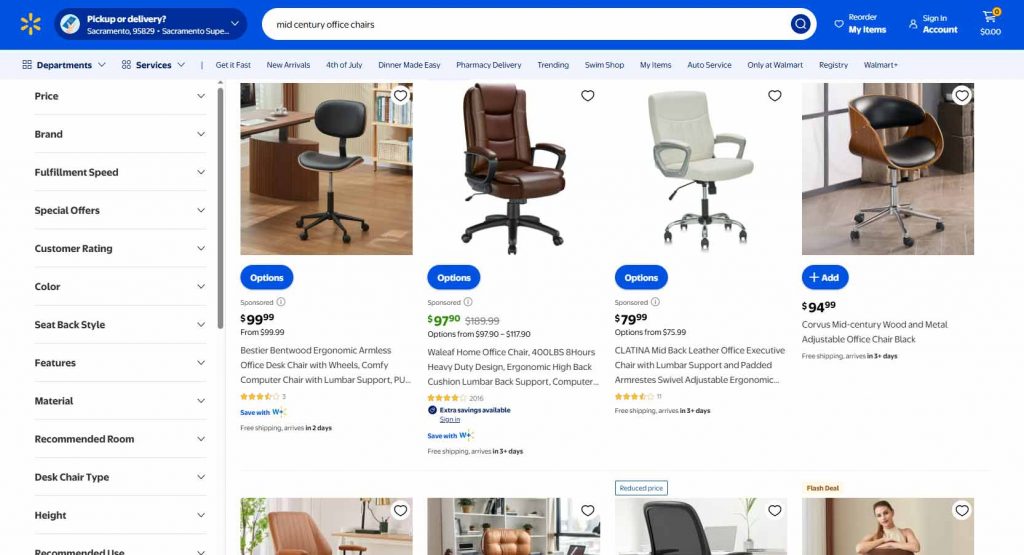
Hayneedle’s selection of mid-century modern office chairs falls somewhere between the minimal Laura Davidson and the endless Amazon catalog. Their array of mid-century designs is affordable and versatile, with chairs that match almost any style. While they may be part of the Walmart family, these chairs are anything but second-rate.
MCM office chair example: Waleaf ($97)
10) Target

Why splurge when you can save? As usual, Target is a hidden gem, offering a sturdy selection of mid century modern office chairs for some of the cheapest prices out there. Many of the chairs they offer are from the same designers as these other stores—Christopher Knight, LumiSource, Armen Living, etc.—at reduced prices.
MCM office chair example: Lombardi ($136)

A quality payroll service is one of the most invaluable tools any entrepreneur can have. Whether you’re a small business owner or an HR manager, paying your employees on time is crucial. This makes choosing a service even more weighty, after all, it is a heavy administrative burden. The good thing is, you can outsource this duty to an online payroll processor.
According to statistics, 49% of workers begin a new job search after just two paycheck errors, and with 65% of workers living paycheck to paycheck, it’s more important than ever to ensure an efficient, effective payroll process.
These services can save you precious time and mitigate potential issues. To make it easy for you to choose, we listed the best online payroll services for 2025.
Top 5 Online Payroll Services
Gusto
Gusto is a great option for both new and experienced payroll administrators, boasting an incredibly clean user interface and a first-rate payroll setup. Gusto lets you manage your employee’s time off (vacation and sick pay), company health insurance, and worker’s comp. Gusto offers excellent mobile access, too. This allows employees to manage aspects of their Gusto profiles, view payday insights, and access Gusto Wallet financial tools.
Gusto offers four tiers of membership, the most affordable of which is the Contractor’s Only plan, which offers unlimited U.S.-based and global contractor payments, supporting more than 100 countries, plus 1099 creation and filing at a rate of $6 per person per month with no base price.
The other three are Simple, Plus, and Premium. Here’s a deeper look into each plan:
Simple
Price:
$40/mo + $6/mo per person
Plan details:
- Full-service single-state payroll including W-2s and 1099s
- Employee profiles and self-service
- Basic hiring and onboarding tools
- Gusto-brokered health insurance administration
- Employee financial benefits
- Payroll and time-off reports
- Custom admin permissions
- Integrations for accounting, time tracking, expense management, and more
Plus
Price:
$80/mo + $12/mo per person
Plan details:
(All Simple plan features +)
- Full-service multi-state payroll including W-2s and 1099s
- Next-day direct deposit
- Advanced hiring and onboarding tools
- PTO management and policies
- Time tracking and project tracking
- Workforce costing and custom reports
- Team management tools
- Full support
Premium
Price:
Bespoke pricing, reach out for a personalized quote
Plan details:
(All Plus plan features +)
- HR Resource Center
- Compliance alerts
- Access to certified HR experts
- Full-service payroll migration and account setup
- Health insurance broker integration
- R&D tax credit discount
- Waived fees and exclusive pricing
- Performance reviews
- Employee surveys and insights
- Dedicated support
QuickBooks Online Payroll
Founded in 1983, Intuit is a California-based financial software company. Since its inception, Intuit has developed into one of the best-known providers of accounting software. Their online payroll service, QuickBooks, includes the essential features you need to run payroll.
QuickBooks offers three tiers of membership. The least expensive membership covers basic accounting features, such as invoices. For more features, check out the Essentials and Plus memberships. Each plan’s features are as follows:
QuickBooks Simple Start (2025)
- Price: $38/month for 1 user
- Best for: Freelancers and small teams with basic payroll needs
Features:
- Automated bookkeeping
- 5 free ACH bank transfers/mo for bills
QuickBooks Essentials (2025)
- Price: $75/month for 3 users
- Best for: Small businesses needing deeper financial tracking
Features:
- Includes all Simple Start features, plus:
- Recurring invoices
QuickBooks Plus (2025)
- Price: $115/month for 5 users
- Best for: Growing businesses with HR and compliance needs
Features:
- Includes all Essentials features, plus:
- AI-powered profit & loss insights
- Anomaly detection and resolution
- Budgeting
QuickBooks Advanced (2025)
- Price: $275/month for 25 users
- Best for: Established businesses with HR and compliance needs
Features:
- Includes all Plus features, plus:
- Custom user management and permissions
- Custom report builder
- Data sync with Excel
- Revenue recognition
- Forecasting
OnPay
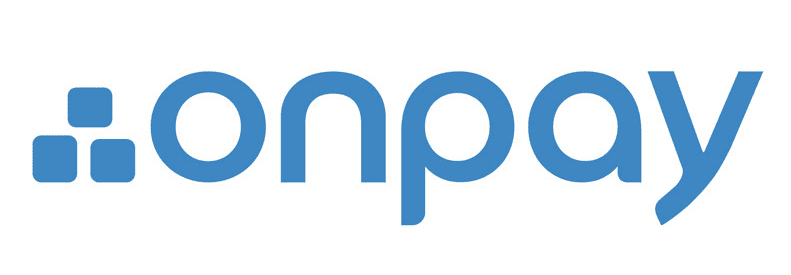
OnPay is a cloud-based full-service payroll processing system capable of running payroll according to a preset schedule, automatically disbursing wages, and calculating and withholding taxes.
OnPay can sync up with several other software your team is already using, making it easy to integrate the service into your team’s system. Another benefit of OnPays model is the simple, transparent pricing structure. No tiers; just one base rate.
Pricing:
$49/mo + $6/mo per employee
SurePayroll

SurePayroll’s award-winning service supports W-2 employees and 1099 contractors. Additionally, it handles 401(k) deductions and manages flexible spending accounts (FSA) and health savings accounts (HSA).
SurePayroll also offers a mobile app— available on both Apple and Android devices.
SurePayroll offers live support through its United States-based support team through chat, email, or phone.
Small Business Payroll
- Price: No Tax Filing: $20/month + $4 per employee, Full Service: $29/month + $7 per employee
- Best for: Small businesses and startups
Features:
- We file and deposit your federal and state taxes!
- Run payroll in 3 simple steps
- Schedule payroll to run automatically
- Unlimited payroll runs and free 2-day direct deposit
- Reports and pay stubs are available online 24/7
- Supports W-2 employees and 1099 contractors
Nanny & Household Payroll
- Price: Full-Service Household, $39/month, includes 1 employee, $10 per additional employee
Best for: Homeowners
Features:
- Signature-ready Schedule H
- We file & deposit your federal and state taxes!
- Run payroll in 3 simple steps
- Schedule payroll to run automatically
- Unlimited payroll runs and free 2-day direct deposit
- Reports & paystubs available online 24/7
- Supports W-2 employees & 1099 contractors
Be sure to choose a payroll service that works for your business, and provides you with the peace of mind that comes with a reliable bookkeeping system. Your employees will thank you.

Merck is currently in talks to acquire Seagen, a biotech company. The Wall Street Journal reports that the transaction is valued at $40 billion. And what happens if Merck acquires Seagen, and how would this acquisition benefit cancer research and treatment? Read more about the Merck Seagen buyout here.
Merck Seagen Buyout
Merck and Seagen are still deciding on their share prices. So far, talks have yet to reach an agreement on $200 per share. Both companies want to settle and finalize their deals before Merck announces its quarterly earnings on July 28. At the time of writing, Seagen’s stock was at $176.19.
With an estimated market value of $235 billion, Merck is looking to expand its presence in the cancer treatment space. The Merck Seagen Buyout could play a major role in that strategy. Since Seagen specializes in targeted cancer therapies, the acquisition would give Merck access to a broader range of oncology products.
Shareholder reactions to the new deal are overwhelmingly positive, and the stocks have been up since talks about the deal have been made public.
But this is not the first time that Merck and Seagen have made the news. Back in 2020, they collaborated because of cancer treatments. Seagen has a drug conjugate (ladiratuzumab vedotin) which would be used in conjunction with Merck’s Keytruda.
Merck reveals that Keytruda is its highest-selling product. It’s immunotherapy for cancer.
And this deal could help Merck offset the possibility of reduced sales because it will lose patent protection in 2028.
As promising as this deal is, there could be scrutiny from antitrust officials since there might be a litigation case from the Federal Trade Commission or Justice Department.
The Seagen buyout isn’t the only deal Merck has made recently. They’ve been busy closing another deal, but with Orion too.
Seagen
As a cancer biotech company, Seagen has therapies to ensure that patients benefit from the treatment and reduce any adverse side effects. Their treatments involve the therapy attacking tumors with toxins.
Merck partnering with Seagen isn’t a bad idea considering that Seagen made $1.4 billion in sales in 2021, most of it coming from Adcetris and Padcev (a treatment for urothelial cancers).
Merck-Orion Deal
In the middle of the Merck Seagen Buyout, Merck has recently partnered with Orion for the ODM-208 and other drugs. These drugs are related to the production of steroids. Orion found how it can combat hormone-dependent cancers and further developed this inhibitor.
Their deal includes that they should develop ODM-208 and promote it to the public together. And Orion will receive a $290 million payment from Merck.
Although they’re co-developing and marketing the new inhibitor, Orion will oversee the manufacturing side.
Co-developing the ODM-208 can help Merck with its current research and treatments for prostate cancer. President and CEO of Orion, Timo Lappalainen, says that this partnership will benefit Merck’s goals of treating cancer worldwide.
Other Ventures: Merck’s Role in the Pandemic
You may have heard about COVID-19 pills, which are a form of treatment for those diagnosed with mild to moderate COVID-19. Merck introduced an antiviral COVID-19 pill to the public. The name: Molnupiravir.
The COVID-19 pill is not a replacement for a vaccination. Instead, it stops the replication of the COVID-19 genetic code and keeps the patient out of the hospital. Not yet FDA-approved, Molnupiravir has been authorized for emergency use since December 23, 2021.
And for other stories, read more here at Owner’s Mag!

What Is Tiktok Pink Sauce? The Viral Condiment, Explained

Did You Drop Your Smartphone in The Ocean? Here’s How to Retrieve It

Gift Guide: 25 Best Gifts for Women for All Occasions

History of the NBA: The Success Behind the Big League

Demio SaaS 2025 Review: Features, Pricing, Pros & Cons

Top 12 Uses for The Metaverse That Will Change Your Life

Top 10 Best Places to Buy a Mid Century Modern Office Chair

Top 10 Best Places to Buy a Mid Century Modern Office Chair

History of the NBA: The Success Behind the Big League

8 Best Equipment for YouTube Every Content Creator Needs

Demio SaaS 2025 Review: Features, Pricing, Pros & Cons

Did You Drop Your Smartphone in The Ocean? Here’s How to Retrieve It

Top 10 Small Business Organization Tools for 2025

Top 12 Uses for The Metaverse That Will Change Your Life
Trending
- Entertainment5 days ago
History of the NBA: The Success Behind the Big League
- Lifestyle4 days ago
Did You Drop Your Smartphone in The Ocean? Here’s How to Retrieve It
- Lifestyle5 days ago
Gift Guide: 25 Best Gifts for Women for All Occasions
- Top Stories4 days ago
What Is Tiktok Pink Sauce? The Viral Condiment, Explained















